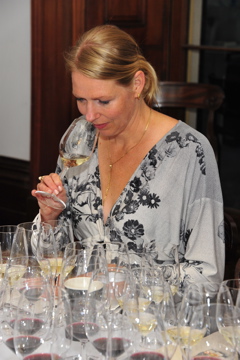This article was first published in Gourmet Rabbit March 2010 www.gourmetrabbit.com
1st course
It all happened very quickly. I attended my first wine appreciation course when barely of legal alcohol drinking age and that was it; I was smitten. I learnt that wine can tell a story – which grapes were used to craft it and where they were grown, how the grapes ended up as wine, what stage of life it’s at – and that’s just the beginning. What a wine reveals in the glass is a never ending, fascinating discovery of the senses for me and as such, it’s been my passion and career ever since. Ernest Hemmingway sums it up beautifully; “Wine offers a greater range for enjoyment and appreciation than possibly any other purely sensory thing which may be purchased.” With practice and study the process of wine assessment provides the ability to gaze ever more deeply into a wine’s soul.
That’s enough about me.
Something I love about wine is demystifying it. Unfortunately it is a subject easily misunderstood and readily complicated. Plus, it tends to harbor elitist associations and that’s truly a load of outdated nuff-nuff. If wine is such an exclusive club then there really shouldn’t have been any hope for me as I am the off-spring of cask-wine-with-soda-water consuming parents. But I digress back to me again, sorry. Luckily today wine is accessible to anyone (that is over legal drinking age) and is ideally accessed in moderation.
Wine evaluation is both an art and science. Everyone’s sensory preferences are unique. And because wine offers a sensory experience, so many factors about its appraisal are subjective – a matter of personal taste. Take the perception of faults as an example; the line between a character being complex and interesting versus a flaw is blurry to say the least. In other words; one person’s glorious whiff of stinky barnyard is another’s foul stench.
Personal taste is influenced by so many factors; including culture and trends. In the 1970’s we loved sweet aromatic wines (remember Leibfraumilch?). This eventually gave way to turbo-charged Chardonnays that slapped us in the mouth with wood and butter and right now us Aussies can’t get enough of Kiwi Sauvignon Blanc.
To understand the science involved in evaluating wine you’ve got to get back to basics; firstly about what wine is and then you can break it into its component parts to assess it. Wine is simply the product of fermented grapes. So when tasting wine, that is pretty much it. Of course there are winemaking influences that can also be present – oak being the most obvious and sometimes the most intrusive – but as a general rule wine is one of the most natural of manufactured products.
There are fewer things added to wine than many, many other food-stuffs; in terms of flavours, colours or preservatives. Take sulphur dioxide for example; wine contains a mere fraction of sulphur compared to something like dried apricots. If you leave apricots out to dry naturally, they turn brown in colour, hardly the glistening-in-the-dark orange hue of the manufactured kind.
But alas, wine tends to get unfairly prejudiced against with restrictions surrounding when, where and to whom it can be sold and advertised. The sulphur dioxide in manufactured dried apricots, for example, is far more likely to bring on an asthma attack than what is in the average glass or two of wine. Consuming too much alcohol can, of course, potentially do damage.
I’ll get off my soap-box now.
I reckon just about anyone can be a great wine taster. Granted, some people have freakily perceptive senses, but to an extent the tasting methodology is a leaned skill. It really depends on how interested one is in developing that skill. Wine analysis is a three-step process; take a look at the wine in the glass, then give it a good whiff, then take a sip and swirl it around your mouth (and spit it out if there’s a spittoon handy and you’re in a formal tasting environment). Of the steps, smelling the wine is the most important as it is the most revealing. In fact, 80% of what you can learn from a wine is from its aromas.
Theoretically, you can be a great wine taster and actually be teetotal, but you probably didn’t really want to know that. The actual taste of the wine mainly helps confirm information gleaned from the prior two steps – sweetness, sourness, bitterness and alcohol level. There are many tools of the trade around to guide you through the wine evaluation process – like a wine aroma wheel and the WSET Systematic Approach to Tasting Wine. (http://www.wsetglobal.com/media/6916/wset_l2wines_sat_en_may2019.pdf)These and others are awesome to help you become more and more precise and focused in your analysis and vocabulary.
Professional tasters run through such a check-list when assessing wines. Many have developed their own over time. When tasting, for example, one check-point is the type and level of its acidity. Is it low/medium or high acid for example and how can it be described; citrus, racy, soft etc etc. To develop one’s skills of analysis, it is very effective to compare and contrast wines. To be able to see how this wine’s acidity compares to the next – that kind of thing.
The great wine author and entrepreneur, Alexis Lichine once wrote; “When it comes to wine, I tell people to throw away the vintage charts and invest in a corkscrew. The best way to learn about wine is the drinking.” While I do agree with Mr Lichine’s sentiments of practice, practice, practice I also believe that the more you learn about wine – varietal characteristics, regional characteristics, how wines are made or example – the more enhanced your tasting experience becomes.
Evaluating wines using a step-by-step process empowers you make more informed choices. Mainly because you understand the reasons why you may or may not like certain characteristics, varieties, wine types, stuff like that. After all – the most important thing about wine is whether or not YOU actually like it.

